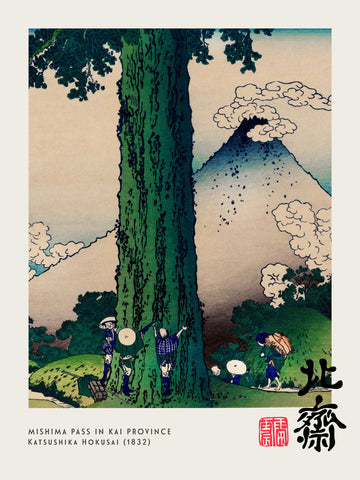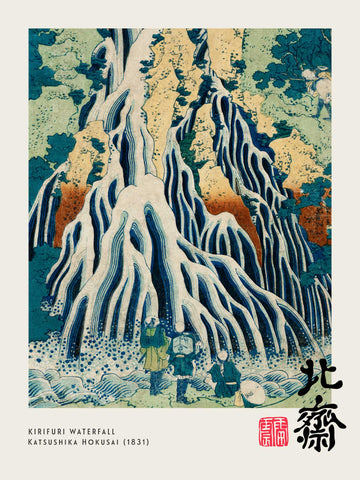7 Artworks By Katsushika Hokusai You Should Know
Introduction
Katsushika Hokusai was a Japanese artist whose most famous piece is "The Great Wave off Kanagawa." The print depicts an enormous wave about to crash down on two small boats in the foreground. The image's incredible detail and visual intricacy have made it one of Japan's most recognized works of art. While this single painting has earned him fame, Katsushika Hokusai had many other works that showcase his talent as an artist. Below are seven great works by Katsushika Hokusai that you should know about:
1. The Great Wave Off Kanagawa, 1831
The Great Wave Off Kanagawa, 1831 by Katsushika Hokusai (1760-1849)
This piece is a Japanese woodblock print created in 1831. It depicts a massive wave exploding onto the shore and leaving destruction behind. The wave was inspired by an actual event in Japan where two boats were capsized by a tsunami. The style of this work is referred to as “unfinished” because it does not have any ink over the entire piece, which allows for closer inspection of each detail and layer within it. The meaning behind this work is that nature is more important than anything else in life, including human beings.
2. Sesshu Ajigawaguchi Tenposan - 1832
The Japanese artist Katsushika Hokusai painted a scroll depicting the Ajigawaguchi Tenposan waterfall in 1832, at the age of 68. The painting was originally created as part of a series called “Thirty-Six Views of Mount Fuji."
The style used in this work is very similar to that of Sesshu's and follows his general principles of composition. It depicts a mountain stream flowing through rocky terrain with trees and other vegetation lining its banks.
3. Mishima Pass In The Province Of Kai
The Mishima Pass in the Province of Kai is a famous Japanese artwork by Katsushika Hokusai. It was created using the ukiyo-e style of woodblock printing and was part of his Thirty-Six Views of Mount Fuji series, which depicted various scenes from around Japan.
The painting depicts a mountain pass in the Kai province, in what is now Kanagawa prefecture south of Tokyo. From afar, we see two travelers approaching an old temple gate as they enter into a dense forest that leads up to Mt. Fuji.
4. Kirifuri Waterfall At Kurokami Mountain In Shimotsuke
This painting is called "Kirifuri Waterfall at Kurokami Mountain in Shimotsuke." It was painted in 1833 and is about 20 by 27 inches.
The waterfall is located on a mountain slope, with the stream flowing down from the top of the mountain toward a pool at the bottom. The artist created this piece during an era when Japan was going through some political upheaval. An example of this can be seen in his choice to use black ink to make all of his background elements darker than usual, while being very light on detail (or “flat”). This causes everything except for the waterfalls themselves to feel distant and almost out of reach—almost like they're trying to escape into another world altogether!
The weather conditions at this time were known for being cold and rainy; Hokusai's use of these same colors create even more drama within Kirifuri Waterfall.
5. Koshu Kajikazawa
Koshu Kajikazawa is an ukiyo-e woodblock print by Katsushika Hokusai. It is one of the most famous and widely recognized works in all of art, with many copies and imitations made over time. The work depicts the waterfall of Kajikazawa in Koshu, a province in Japan. The print is also called "Fine Wind, Clear Weather".
6. Fine Wind, Clear Weather - 1832
Fine Wind, Clear Weather is a woodblock print by Katsushika Hokusai. It was published in 1831, and is one of the Thirty-six Views of Mount Fuji.
Fine Wind, Clear Weather features an image of two boats floating on a lake with Mount Fuji in the distance. The lake is surrounded by stone walls and other buildings, which are likely to represent towns or villages near Lake Ashi (Ashino). In addition to being one of Hokusai's most famous prints, it also appears on Japanese currency due to its popularity among Japanese people; it had been used as the design for 100 yen note from 1999 until 2006 when it was replaced with another work from the same series called “Shoot at dawn”
7. Yoro Waterfall In Mino Province
When you think of waterfalls in Japan, you may find yourself imagining a hot spring. You're not wrong. This is especially true if you live near or have visited Hakone, a popular tourist destination that is known for its many onsen (hot springs).
However, if you're looking to see some truly spectacular waterfalls and are willing to venture off the beaten path just a bit, we've got just the thing for you: Yoro Waterfall. Located in Mino Province—one of Japan's four main regions and home to Mount Fuji—Yoro Waterfall is one of the most famous destinations in all of Japan. Its breathtaking beauty has been featured in countless paintings by Katsushika Hokusai himself as well as other artists from across Asia and Europe over centuries past.
Yoro Waterfall has two tiers: upper and lower. The upper tier stands at about 70 meters high with an average width around 10 meters; it's known as one of Hokusai's most photographed works due to its unique shape resembling an upside down triangle when viewed from above or below respectively! The lower tier measures some 20 meters tall by 5 meters wide with clear blue waters flowing gently over smooth rocks while mosses hang down like curtains along either side creating quite an enchanting scene indeed!
Katsushika Hokusai was a Japanese artist whose most famous piece is "The Great Wave off Kanagawa."
Katsushika Hokusai was a Japanese artist whose most famous piece is "The Great Wave off Kanagawa."
You may have seen this picture on the cover of a math textbook or in an art history book. It's one of those works of art that everyone recognizes, but few people know the artist's name. (If you're one of them and want to know, go ahead and scroll past this paragraph.)
Katsushika Hokusai was born in 1760 and lived until 1849. He started his career as an apprentice wood-carver and later turned to painting at around age 50.
His most famous work is "The Great Wave off Kanagawa," which depicts a massive wave crashing against rocks on shore with Mount Fuji looming behind it all—a huge contrast from his first career choice! The wave itself is so big it looks like it might swallow up everything else on either side of it; if you look closely enough at any part of this image, there are smaller details hidden within its shape that remind us how vast nature can be when we take time to notice them all around us today too!
Conclusion
Katsushika Hokusai was a Japanese artist whose most famous piece is "The Great Wave off Kanagawa." In this article, we took a look at seven of his works that you should know about and why they're important.















